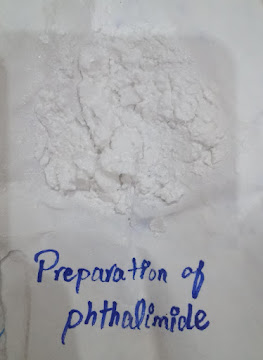Experiment No. 1
Synthesis of
orthochlorobenzoic acid from pthalic anhydride:
Organic Synthesis:
It is a Special branch of synthesis and
Concerned with the international-construction of organic compounds. It Can
ocurr in many Steps. Above synthesis of o-Chloro benzoic acid occur in
following Steps:
Step I:
Synthesis of Pthalamide from phalic anhydride
Step II:
Anthanilic acid from Pthalamide
Step III:
Ortho chlorobenzoic acid from anthranilic acid
Step I
Synthesis of
Pthalamide from pthalic anhydride
Chemicals required:
- phthalic anhydride 10 gm
- Ammonium Carhonate 10 equivalent quantity
Theory:
The most important Synthesis of Pthalamide is
dehydrative Condensation of Phthalic anhydride at high temperature with primary
amines ((NH4)2CO3), when amine is not readily
availible, the direct of N-alkylation of Pthalimides with the alcohols and of
Potasium Pthalamide with alkyl halide are Popular to protect Phthalamines.
This synthesis occurs in the absence of solvent. The two moles of CO₂ gas and water
molecules evolved in this process.
Chemical Equation:
Mechanism:
Procedure:
I mixed thoroughly Phthalic anhydride and 10g ammonium
Carbonate in morter and Pistle. Then I placed the mixture in 200ml round bottom
flask. Then, I fixed this flask in sand bath and I heated with frequently
shaking for 1-2 hours until the reaction mixture got fused. I stopped
heating when I observed shiny crystals. The hot reaction was poured into
porcelain and allowed to Cool and finally broken into pieces and powdered.
Observations:
Melting Point:
Melting point of
Substance is the temperature at which it Changes state from solid to liquid at
atmospheric pressure. The melting point of Pthalamide is 234oC
Calculations:
Mass of
pthalic anhydride = 10g
Molecular mass
of pthalic anhydride = 148 g/mol
Moles of
pthalic anhydride = x m/M
10g÷148g/mol = 0.06756
moles
Moles of
pthalic anhydride = 0.06756 moles
Mass of
ammonium carbonates = 10g
Molecular mass
of ammonium carbonates = 96g/mol
Moles of
ammonium carbonates = x m/M
10g÷96g/mol = 0.1042
moles
Moles of
ammonium carbonates = 0.1042 moles
From chemical
equation;
1eq of pthalic
anhydride = 1eq of ammonium carbonates = 1eq of pthalimide
So,
0.6756 moles
of pthalic anhydride=0.06756 moles of ammonium carbonates=0.06756
moles of
pthalimide
Molecular mass of pthalimide = 147 g/moles
Moles of pthalimide = 0.6756 moles
Mass of pthalimide = n×M
(0.6756mol)(147
g/mol) = 9.92g
Theoretical yield = 9.92g
Actual yield = 7g
%age yield =
Actual yield ÷ Theoretical yield ×100
7/9.92×100 = 70.56%
%age yield of
pthalimide = 70.56%
Yield:
The Calculated
amount of product is theoretical yield. The amount of product actually obtained
is actual yield and when actual yield is divided by theoretical give obtained
yield.
It would give
expected product yield.




No comments:
Post a Comment